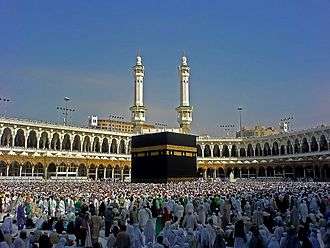Tarawih
| Part of a series on |
| Islamic jurisprudence (fiqh) |
|---|
| Islamic studies |

Tarawih (Arabic: تراويح) refers to extra prayers performed by Sunni Muslims at night in the Islamic month of Ramadan.
Overview
Tarawih prayers are prayed in pairs of two and can be prayed in at least 20 raka‘āt according to the Hanafi and Shafi'i schools of Sunni Islam. A break is taken after every 4 raka‘āt. This prayer is performed only during Ramadan of the Islamic calendar after salat of Isha. Muslims believe it is customary to attempt a khatm "complete recitation" of the Quran as one of the religious observances of Ramadan by reciting at least one juz' per night in tarawih. Tarawih prayers are considered optional, not obligatory.
Sunni views
In all the sunni hadith scriptures, the prayer Tarawih has been mentioned as Qiyamul Layl min Ramadan (Standing of night in Ramadan) and Qiyam-ar-Ramadan (Standing of Ramadan). A majority of Sunni Muslims regard the Tarawih prayers as Sunnat Mu'akkadah, a salaat that was performed by the Islamic prophet Muhammad very consistently. Sunni Muslims believe tarawih is a Sunnah salat and may be performed at home if one is unable to attend a mosque. According to this tradition, Prophet Muhammad initially prayed the tarawih in congregation during Ramadan which is evident in ahadith. He prayed in congregation for three consecutive nights [1] but discontinued this practice out of fear that it would be made mandatory, rather than sunnah. During the time when Umar was the caliph, he reinstated the praying of Tarawih in congregation [2] since there was no longer any misapprehension of it being made mandatory. However, Malik ibn Anas prefers that Tarawih be prayed at home, if one has a strong intention to do so.
Shia views
The Shia view differs among the three main schools of thought, Ismaili, Twelvers and Zaydis. However, some Zaydis have been known to regard tarawih as sunnah. Alevi Muslims in Turkey have no Tarawih prayer and see it as bid‘ah (بدعة).
Twelvers believe in the Tahajjud prayer or Salatul layl (night prayer) which Muhammad recommended. It is recommended throughout the year, especially during nights of Ramadan.[3]
Salat al-Layl or Tahajjud prayer is made up of eleven rak’ats.
- The first eight rak’ats are prayed as normal in pairs of two rak’ats each with the niyyah of Nawafilat al-Layl (the prayer of the night).
- The next two rak’ats are prayed with the niyyah of Salat al-Shaf’a (the prayer of forgiveness).
- The remaining rak’at is prayed with the niyyah of Salat al-Witr.
In the last rak’at, Qunut is recited before or after ruku' and the Salat is completed as usual with Tashahhud and Salaam.
- Shia Imami Ismaili Muslims believe Tahajjud prayer or Bayt al-Khayal prayer is recommended throughout the year particularly on Friday (Jumma) or Chand Rat (First night of every Islamic month).
Notes
- ↑ "Sahih Muslim, Book 4, Hadith 1663". Sunnah.com. Retrieved 1 September 2015.
Abu Huraira reported: The Messenger of Allah used to exhort (his Companions) to pray (at night) during Ramadan without commanding them to observe it as an obligatory act, and say: He who observed the night prayer in Ramadan because of faith and seeking his reward (from Allah), all his previous sins would be forgiven. When Allah's Messenger died, this was the practice, and it continued thus during Abu Bakr's caliphate and the early part of 'Umar's caliphate.
- ↑ "Sahih Bukhari, Vol. 3, Book 32, Hadith 227". Retrieved 1 September 2015.
Abdur Rahman bin 'Abdul Qari said, "I went out in the company of 'Umar bin Al-Khattab one night in Ramadan to the mosque and found the people praying in different groups. A man praying alone or a man praying with a little group behind him. So, 'Umar said, 'In my opinion I would better collect these (people) under the leadership of one Qari (Reciter) (i.e. let them pray in congregation!)'. So, he made up his mind to congregate them behind Ubai bin Ka'b. Then on another night I went again in his company and the people were praying behind their reciter. On that, 'Umar remarked, 'What an excellent Bid'a (i.e. innovation in religion) this is; but the prayer which they do not perform, but sleep at its time is better than the one they are offering.' He meant the prayer in the last part of the night. (In those days) people used to pray in the early part of the night."
- ↑ Islamic Laws by Ayatollah Sistani
References
- John L. Esposito: The Oxford Dictionary of Islam. Oxford University Press US 2004, ISBN 978-0-19-512559-7, p. 276 (restricted online version, p. 276, at Google Books)
| |||||||||||||||||||||||||||||||||||||||||||
| ||||||||||||||||||
